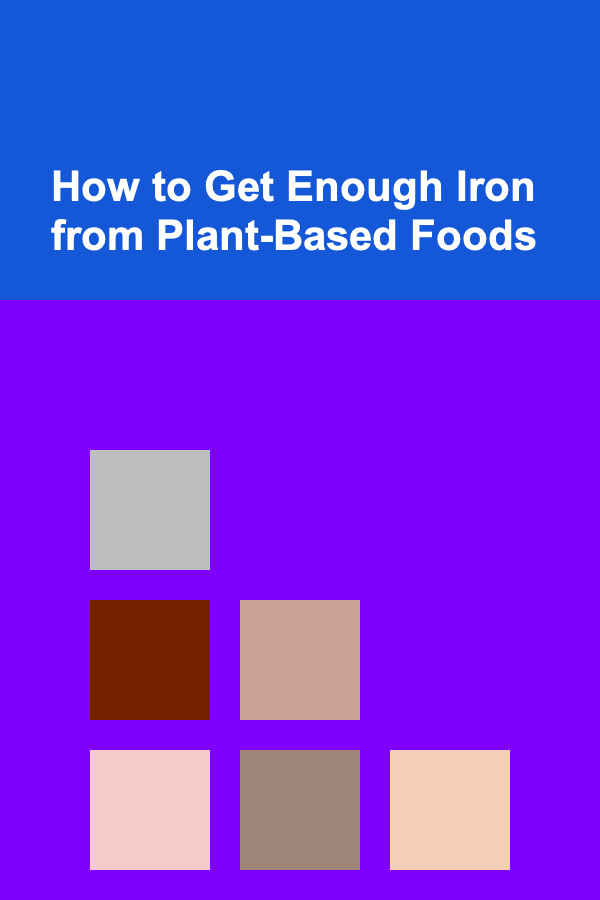
How to Get Enough Iron from Plant-Based Foods
ebook include PDF & Audio bundle (Micro Guide)
$12.99$7.99
Limited Time Offer! Order within the next:

Iron is a crucial mineral in the body, playing an essential role in the production of hemoglobin, the protein in red blood cells that transports oxygen throughout the body. Iron is also involved in energy metabolism, immune function, and cell growth. However, iron deficiency is one of the most common nutrient deficiencies worldwide, and it can lead to anemia, fatigue, weakened immune function, and reduced cognitive abilities.
While animal-based foods such as red meat, poultry, and fish are known to be rich sources of iron, plant-based foods can also provide ample amounts of this vital nutrient. For those following a plant-based or vegetarian diet, ensuring an adequate intake of iron is crucial for maintaining overall health and well-being. This article explores how to get enough iron from plant-based foods, the types of iron found in plants, and practical dietary tips for optimizing iron absorption.
Understanding Iron in Plant-Based Foods
Iron exists in two primary forms in food: heme and non-heme iron. Heme iron is primarily found in animal-based foods and is more readily absorbed by the body. Non-heme iron, which is the form of iron found in plant-based foods, is not as easily absorbed but can still provide a significant amount of iron when consumed in adequate quantities.
1. Heme vs. Non-Heme Iron
- Heme Iron: Found in animal products, particularly red meat, poultry, and fish. Heme iron is absorbed more efficiently by the body, with absorption rates typically ranging from 15% to 35%.
- Non-Heme Iron: Found in plant-based foods like beans, lentils, tofu, spinach, and fortified cereals. The absorption of non-heme iron is much less efficient, generally ranging from 2% to 20%. However, its absorption can be improved by consuming it alongside foods rich in vitamin C, which enhances the bioavailability of non-heme iron.
2. Bioavailability of Iron
Bioavailability refers to the proportion of a nutrient that is absorbed and utilized by the body. Non-heme iron, while abundant in plant-based foods, is less bioavailable than heme iron. Therefore, those relying on plant-based sources must pay closer attention to factors that can enhance or inhibit iron absorption.
Key Plant-Based Sources of Iron
Plant-based foods can be excellent sources of iron, and with careful planning, it's entirely possible to meet your daily iron requirements without consuming animal products. The following are some of the richest sources of iron in plant-based diets:
1. Legumes
Legumes, such as beans, lentils, chickpeas, and peas, are excellent sources of iron. These foods are not only rich in iron but also provide a wealth of fiber, protein, and other nutrients that support overall health.
- Lentils: A cup of cooked lentils provides about 3.5 mg of iron.
- Chickpeas: A cup of cooked chickpeas offers around 4.7 mg of iron.
- Black beans: One cup of cooked black beans contains about 3.6 mg of iron.
Incorporating a variety of legumes into your meals can help you achieve a substantial portion of your daily iron intake.
2. Tofu and Tempeh
Tofu and tempeh, both made from soybeans, are rich in non-heme iron. They are versatile and can be used in a variety of dishes, from stir-fries to salads.
- Tofu: A 4-ounce serving of tofu contains approximately 3.6 mg of iron.
- Tempeh: A 3-ounce serving of tempeh provides about 3.5 mg of iron.
Both of these soy-based products are also excellent sources of plant-based protein, making them a great addition to a well-balanced diet.
3. Leafy Green Vegetables
Leafy greens like spinach, kale, and Swiss chard are well-known plant-based sources of iron. While the iron content in these vegetables may not be as high as in legumes or soy products, they still contribute a valuable amount of iron to the diet.
- Spinach: A cup of cooked spinach contains about 6.4 mg of iron.
- Kale: A cup of cooked kale provides around 1.3 mg of iron.
However, it's worth noting that spinach contains oxalates, which can inhibit iron absorption, so it's important to consume these vegetables alongside vitamin C-rich foods to optimize iron absorption.
4. Nuts and Seeds
Nuts and seeds are another good source of iron, particularly pumpkin seeds, sesame seeds, and hemp seeds. They also provide healthy fats and protein, making them a great addition to a plant-based diet.
- Pumpkin seeds: A 1-ounce serving provides about 2.5 mg of iron.
- Sesame seeds: A 1-ounce serving provides about 4.1 mg of iron.
These can be added to smoothies, salads, or sprinkled on top of dishes to boost your iron intake.
5. Whole Grains
Whole grains such as quinoa, oatmeal, brown rice, and farro are rich in iron and other essential nutrients like fiber and B vitamins. Whole grains are an easy addition to meals and can be used as the base for a variety of dishes.
- Quinoa: A cup of cooked quinoa contains about 2.8 mg of iron.
- Oats: A cup of cooked oats provides approximately 2.1 mg of iron.
Incorporating a variety of whole grains into your diet can help ensure you get enough iron, along with other important nutrients.
6. Fortified Foods
Many plant-based foods, such as breakfast cereals, plant-based milk, and nutritional yeast, are fortified with iron. These fortified foods can be a great way to boost your iron intake, especially for those following a vegan or vegetarian diet.
- Fortified cereals: A serving can provide anywhere from 4 to 18 mg of iron, depending on the brand and type of cereal.
- Plant-based milk: Many brands of plant-based milk (such as soy, almond, or oat milk) are fortified with iron, providing about 1--3 mg per serving.
- Nutritional yeast: A tablespoon of nutritional yeast contains about 0.5--1 mg of iron.
Fortified foods are a reliable source of non-heme iron and can be especially helpful for individuals who may struggle to meet their iron needs through whole foods alone.
Enhancing Iron Absorption
While plant-based foods contain iron, the absorption of non-heme iron can be less efficient than heme iron. However, there are several strategies you can use to improve iron absorption from plant-based foods:
1. Pair Iron-Rich Foods with Vitamin C
Vitamin C significantly enhances the absorption of non-heme iron. Consuming foods rich in vitamin C, such as citrus fruits, bell peppers, strawberries, and broccoli, alongside iron-rich plant-based foods can increase iron absorption by up to four times.
For example:
- Spinach and orange slices: Enjoy a spinach salad with slices of orange to boost iron absorption.
- Lentil stew with tomatoes: Tomatoes are rich in vitamin C and can be paired with lentils to improve iron absorption.
2. Avoid Iron Inhibitors During Meals
Certain compounds in foods can inhibit the absorption of iron. These include:
- Phytates: Found in grains, legumes, and seeds, phytates can bind to iron and reduce its absorption.
- Calcium: High amounts of calcium (from dairy or supplements) can inhibit iron absorption.
- Polyphenols: Found in tea, coffee, and some fruits, polyphenols can interfere with iron absorption.
While these inhibitors don't mean you should avoid these foods altogether, it's best to consume them separately from iron-rich meals to optimize absorption.
3. Soaking and Sprouting
Soaking and sprouting grains, legumes, and seeds can reduce their phytate content, making the iron more bioavailable. For example, soaking beans and lentils overnight before cooking can help decrease phytates and improve iron absorption.
4. Cooking with Cast Iron Cookware
Cooking with cast iron pots and pans can actually increase the iron content of your food, especially when cooking acidic foods like tomatoes. The iron from the cookware leaches into the food, providing an additional source of iron.
Signs of Iron Deficiency and How to Prevent It
Iron deficiency can lead to anemia, a condition characterized by a low number of red blood cells or hemoglobin. Symptoms of iron deficiency anemia include:
- Fatigue
- Pale skin
- Shortness of breath
- Dizziness
- Cold hands and feet
To prevent iron deficiency, it's important to monitor your iron intake and ensure you're consuming enough iron-rich foods daily. Women, particularly those who are pregnant or menstruating, and individuals following a vegan or vegetarian diet are at higher risk for iron deficiency. Regularly incorporating iron-rich plant foods and enhancing absorption through the strategies mentioned above can help prevent iron deficiency.
Conclusion
Getting enough iron from plant-based foods is entirely possible with a thoughtful and well-planned diet. While non-heme iron is less efficiently absorbed than heme iron, consuming a variety of iron-rich plant foods---such as legumes, tofu, leafy greens, nuts, seeds, whole grains, and fortified foods---can help meet your iron needs. Pairing these foods with vitamin C-rich foods and avoiding iron absorption inhibitors will further enhance your ability to absorb iron effectively.
By understanding the different sources of plant-based iron and how to optimize absorption, you can easily incorporate iron into a healthy, balanced, and sustainable plant-based diet. If you're concerned about your iron levels or suspect a deficiency, it's always a good idea to consult with a healthcare professional who can provide personalized advice and support. With the right dietary choices, iron deficiency is preventable, and you can maintain optimal health on a plant-based diet.

How to Choose the Right 4 Bedroom Homes for Rent for Your Family
Read More
How to Clean Your Home Like a Professional Cleaner
Read More
How to Ensure Your Rental Property Meets Local Code Requirements
Read More
How to Identify the Best Free Online Budget Tool for Beginners
Read More
How to Save Money on Groceries Without Sacrificing Quality
Read More
How to Create a Reptile Humidity and Ventilation Checklist
Read MoreOther Products

How to Choose the Right 4 Bedroom Homes for Rent for Your Family
Read More
How to Clean Your Home Like a Professional Cleaner
Read More
How to Ensure Your Rental Property Meets Local Code Requirements
Read More
How to Identify the Best Free Online Budget Tool for Beginners
Read More
How to Save Money on Groceries Without Sacrificing Quality
Read More